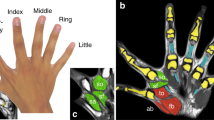Abstract
A specially designed hand-support device was evaluated to determine its effectiveness in assisting nonspeaking mentally handicapped children transition from facilitated communication (FC) to independent typing. Six autistic individuals (age range: 5 to 31) participated in the main experiment. All six had been reported to be moderately to highly proficient in the use of FC prior to the study. Pre- and posttraining tasks included pointing to pictures, numbers, and letters as well as copying single words by typing on a keyboard or letterboard. After 8 weeks of training, subjects' ability to point or type on all four tasks was assessed in three different conditions: (a) with an experienced facilitator, (b) independently, and (c) with the mechanical hand-support system. Postassessment measures did not reveal any evidence of independent communication with or without the device. An informal extension of the study, in which four of the original six subjects and three additional subjects were included for 4 additional months, also failed to provide evidence of significant communication.
Similar content being viewed by others
REFERENCES
Bebko, J. M., Perry, A., & Bryson, S. (1996). Multiple method validation study of facilitated communication: II. Individual differences and subgroup results. Journal of Autism and Developmental Disorders, 26, 19–42.
Berger, C. L. (1994a). Facilitated communication: A positive validation study of multiple subjects. The Catalyst, 11, 2–3.
Berger, C. L. (1994b). Facilitated communication: Part II. A positive validation study of multiple subjects. The Catalyst, 11, 8–10.
Biklen, D. (1990). Communication unbound: Autism and praxis. Harvard Educational Review, 60, 291–314.
Biklen, D. (1993). Communication unbound. New York: Teachers College Press.
Bomba, C., O'Donnell, L., Markowitz, C., & Holmes, D. L. (1996). Evaluating the impact of facilitated communication on the communicative competence of fourteen subjects with autism. Journal of Autism and Developmental Disorders, 26, 43–58.
Crossley, R. (1980). Annie's coming out. New York: Penguin.
Crossley, R. (1994). Facilitated communication training. New York: Teachers College Press.
Green, G. (1994). The quality of the evidence. In H. C. Shane (Ed.), Facilitated communication: The clinical and social phenomena. San Diego, CA: Singular.
Jacobson, J. W., Mulick, J. A., & Swartz, A. A. (1995). A history of facilitated communication: Science, pseudoscience, and antiscience. American Psychologist, 50, 750–765.
Oppenheim, R. C. (1961, June). They said my child was hopeless. Saturday Evening Post, 23, 56–58.
Oppenheim, R. C. (1974). Effective teaching methods for autistic children. Springfield, IL: Charles C Thomas.
Shane, H. C. (Ed.). (1994). Facilitated communication: The clinical and social phenomena. San Diego, CA: Singular.
Author information
Authors and Affiliations
Rights and permissions
About this article
Cite this article
Edelson, S.M., Rimland, B., Berger, C.L. et al. Evaluation of a Mechanical Hand-Support for Facilitated Communication. J Autism Dev Disord 28, 153–157 (1998). https://doi.org/10.1023/A:1026044716536
Issue Date:
DOI: https://doi.org/10.1023/A:1026044716536




